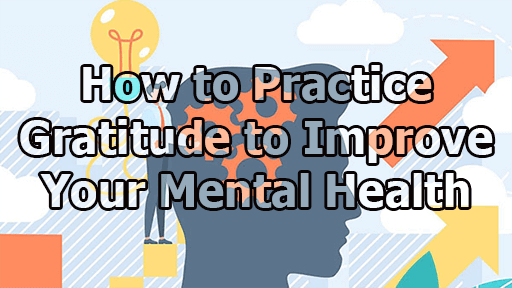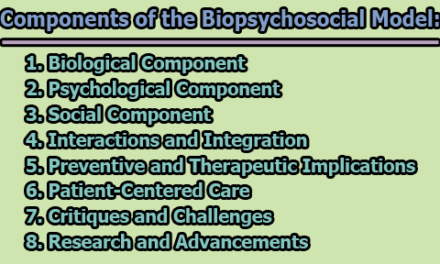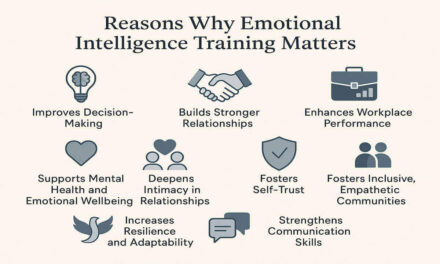How to Practice Gratitude to Improve Your Mental Health:
In today’s fast-paced, stress-filled world, mental health has become a growing concern for people of all ages. While therapy, medication, and self-care routines are commonly discussed, one often overlooked yet powerful tool for emotional well-being is gratitude. Practicing gratitude isn’t just about saying “thank you”—it’s about cultivating a mindset that focuses on appreciation, positivity, and connection. Research in psychology and neuroscience shows that gratitude can rewire the brain, improve mood, reduce anxiety and depression, and strengthen relationships. This article explores how to practice gratitude to improve your mental health.
1. Keep a Daily Gratitude Journal: Keeping a gratitude journal is a highly effective and research-backed way to nurture a positive mental outlook. It involves writing down things you’re thankful for—daily or several times a week—which can range from simple pleasures like a warm cup of tea to more significant events like a friend’s support during a tough time.
The act of journaling helps reinforce positive memories, shifting your mental focus from problems to blessings. According to Emmons and McCullough (2003), individuals who kept daily gratitude journals reported significantly higher levels of optimism, felt better about their lives, and exercised more compared to those who focused on daily irritations or neutral life events. This is because gratitude journaling helps “retrain the brain” to notice the good, which strengthens emotional regulation and counters the negativity bias—the human tendency to dwell more on negative experiences.
Moreover, journaling provides an opportunity for introspection and mindfulness. By reflecting on what went well and why, people begin to notice patterns of positive events and supportive relationships, which enhances their self-awareness and deepens their emotional resilience.
2. Write a Gratitude Letter (Even If You Don’t Send It): A powerful and emotional practice is writing a letter of appreciation to someone who has had a meaningful impact on your life—perhaps a mentor, family member, friend, or even a stranger who changed your perspective. The act of expressing gratitude in writing, even without delivering it, has been shown to significantly boost mood and reduce symptoms of depression.
In a well-known study, participants who wrote and delivered a gratitude letter reported significantly higher happiness scores and lower depression scores compared to control groups (Seligman, Steen, Park, & Peterson, 2005). Interestingly, even those who didn’t send the letter experienced benefits simply from reflecting and articulating their gratitude.
Writing a letter allows for deep emotional processing and helps you reconnect with important positive moments and people in your life, enhancing feelings of meaning and connection.
3. Practice Gratitude Before Sleep: Ending your day with gratitude can help calm your mind and improve your sleep quality. Instead of reviewing worries or your to-do list, reflect on three things that went well today and why they happened. This practice, also known as the “Three Good Things” exercise, helps shift your mind toward positivity and satisfaction.
According to Emmons and McCullough (2003), individuals who practiced gratitude before bed experienced better sleep duration and quality, as well as improved mood upon waking. It works by reducing intrusive negative thoughts and promoting a peaceful mental state, preparing the brain for restful sleep.
This practice is especially useful for people who struggle with nighttime anxiety, as it gently redirects mental focus away from stress and toward peace.
4. Create a “Gratitude Jar”: A gratitude jar is a simple yet powerful tool: every day (or as often as you like), write something you’re grateful for on a slip of paper and place it in a jar. Over time, the jar fills with visual evidence of positivity. On difficult days, you can read through the slips to remind yourself of brighter moments.
This visual accumulation of gratitude can counter negative cognitive biases—our natural tendency to focus on threats or problems. According to Lyubomirsky, Sheldon, and Schkade (2005), consistent positive activities like gratitude journaling or visualization can significantly increase long-term well-being when done with intention and variety.
The jar itself becomes a physical symbol of hope, helping to rewire your brain to focus more readily on the good and making it easier to shift from stress to serenity.
5. Say “Thank You” More Often—And Mean It: Expressing gratitude verbally, especially when done sincerely and with intention, can significantly boost both your mental health and the emotional well-being of those around you. A heartfelt “thank you” does more than fulfill social etiquette—it validates the other person’s efforts and strengthens the emotional bond between you.
Studies show that expressing gratitude face-to-face improves interpersonal relationships, increases social support, and lowers levels of loneliness and depression (Algoe, Haidt, & Gable, 2008). When you thank someone and explain why you appreciate them, it fosters a stronger connection and enhances your own sense of belonging. This is particularly important, as social connection is one of the strongest predictors of psychological well-being.
Moreover, expressing gratitude publicly or in group settings (e.g., team meetings, classrooms, family dinners) sets a positive tone and models a culture of appreciation that others are likely to adopt, amplifying its psychological impact.
6. Engage in Mindful Gratitude Meditation: Mindful gratitude meditation is a structured practice that combines the principles of mindfulness—nonjudgmental awareness of the present moment—with focused reflection on things you are grateful for. In this practice, individuals sit quietly, breathe deeply, and bring to mind people, experiences, or circumstances they appreciate, while consciously savoring the feelings those memories evoke.
This type of meditation has been found to enhance mood, lower cortisol levels, and increase self-compassion (Shapiro, Astin, Bishop, & Cordova, 2005). It allows individuals to pause from the rush of daily life and reconnect with a sense of abundance, reducing feelings of anxiety and scarcity. Practicing gratitude in this mindful way strengthens the neural pathways associated with positive emotion, making it easier to access those emotions in everyday life.
Incorporating even 10 minutes of gratitude meditation into your daily routine can lead to measurable improvements in mental clarity, emotional regulation, and life satisfaction.
7. Reframe Negative Experiences with Gratitude: One of the more advanced but profoundly healing practices of gratitude is learning to find something to appreciate even in difficult or painful experiences. This does not mean denying hardship or pretending everything is okay—it means looking for lessons, growth, or unexpected blessings that may have come from adversity.
This reframing process, often referred to as “benefit finding,” is a key coping strategy in positive psychology. Research has shown that individuals who are able to recognize value in their challenges tend to recover faster from trauma and show greater psychological resilience (Fredrickson, 2004). For instance, someone might reflect on how a job loss led to a more fulfilling career path, or how a personal health scare motivated lasting lifestyle changes.
Practicing gratitude in this way rewires how the brain processes pain and promotes post-traumatic growth—a phenomenon where people emerge from hardship with increased inner strength and deeper appreciation for life.
8. Celebrate Small Wins: Many people overlook minor victories in pursuit of big goals, but acknowledging and appreciating small accomplishments can significantly impact motivation and self-esteem. Celebrating small wins—like completing a workout, having a productive conversation, or learning something new—reinforces a growth mindset and encourages forward momentum.
According to Amabile and Kramer (2011), recognizing progress is one of the most powerful drivers of positive emotion in the workplace and in life. When people pause to be grateful for small steps forward, they build confidence and stay emotionally connected to their goals. Over time, this accumulation of micro-gratitudes can help buffer against burnout, anxiety, and self-doubt.
You can cultivate this habit by ending each day with a question like: “What’s one thing I did today that I’m proud of or grateful for?” This simple reflection builds a sense of accomplishment and helps anchor your self-worth in ongoing effort rather than perfection.
9. Volunteer or Give Back to Others: Helping others is a powerful way to evoke gratitude. When you volunteer your time or resources to people in need, you not only contribute to their well-being, but you also gain perspective on your own life. Seeing how others live with different struggles often fosters a deeper appreciation for your own blessings, even during your personal challenges.
This practice is backed by the concept of “helper’s high”—the emotional boost that comes from doing good for others. Studies have found that volunteering leads to increased happiness, lower depression, and even longer life expectancy (Post, 2005). Giving back reinforces feelings of purpose and gratitude simultaneously, creating a feedback loop where the more you give, the more grateful you become.
Whether it’s serving meals at a shelter, mentoring a young person, or simply listening to a friend in need, acts of service help cultivate compassion, empathy, and gratitude—all of which are pillars of mental wellness.
10. Start a Gratitude Circle or Group Practice: Practicing gratitude in a group setting—whether among friends, family, students, or coworkers—creates a shared culture of appreciation. A “gratitude circle” involves each person taking a turn to express something they’re thankful for, often on a regular basis like weekly meetings, family dinners, or group chats.
This communal expression fosters emotional connection, trust, and empathy among participants. According to Emmons and Shelton (2002), gratitude is inherently social—it builds and strengthens relationships, especially when expressed collaboratively. When people share gratitude in a safe group setting, it not only uplifts the sharer but also positively affects the listeners, creating a ripple effect of warmth and belonging.
Over time, this kind of group gratitude reinforces mutual support and encourages people to notice and vocalize good things more often, promoting collective mental well-being.
11. Use Visual Reminders and Gratitude Cues: Sometimes, we simply forget to practice gratitude—not because we’re ungrateful, but because we’re distracted or overwhelmed. Visual reminders, such as sticky notes, phone wallpapers, affirmation boards, or inspirational quotes, can act as powerful gratitude cues.
These reminders help redirect attention to what’s going well, especially during stressful moments. Behavioral science supports the idea that environmental cues shape behavior. According to Wood and Neal (2007), habit formation is strongly tied to context—when people are surrounded by reminders of their goals or values, they are more likely to act on them.
You can place a gratitude quote on your mirror, set a phone alarm titled “What went well today?”, or keep a bracelet that reminds you to reflect on something good whenever you see it. Over time, these cues nudge your brain toward a gratitude mindset more automatically.
12. Practice Gratitude with Children: Teaching and practicing gratitude with children not only nurtures their emotional intelligence but also enhances your own sense of thankfulness. Engaging in simple activities like gratitude storytelling, thank-you card crafting, or bedtime gratitude sharing helps instill lifelong positive habits.
Research by Froh, Sefick, and Emmons (2008) found that children who participated in gratitude activities showed improved mood, better social behavior, and increased satisfaction with their schools and families. Involving kids in these practices also increases adult awareness, as parents and educators begin noticing more everyday joys through the lens of a child.
When practiced together, gratitude becomes part of the family or classroom culture, improving group harmony and reducing conflict while promoting a more emotionally supportive environment.
13. Reflect on What Life Would Be Like Without Certain Things: This powerful gratitude technique involves mentally subtracting something valuable from your life and imagining how life would feel without it—whether it’s a relationship, a job, your home, or even your health. This “negative visualization” doesn’t focus on loss for its own sake, but rather to awaken a deeper appreciation for what is present.
Koo, Algoe, Wilson, and Gilbert (2008) found that participants who imagined the absence of a positive life event (e.g., never having met their partner) reported greater gratitude and happiness than those who merely thought about the event’s presence. This is because counterfactual thinking (what might not have happened) intensifies awareness of how fortunate we are.
This method is especially helpful during times when gratitude feels forced. Instead of listing things you’re thankful for, reflect on what life might be like without them—and watch appreciation grow naturally.
14. Keep a “Gratitude Wall” in a Shared Space: A gratitude wall is a community-driven space—physical or digital—where people can post notes of appreciation, kind words, or positive moments. It can be a corkboard in a school hallway, a wall in an office, a digital shared document, or a social media thread.
This collective expression of gratitude has a dual benefit: it boosts morale and belonging for those who contribute, and it uplifts anyone who reads it. According to Watkins, Woodward, Stone, and Kolts (2003), witnessing acts of gratitude—even as a bystander—can increase positive affect and feelings of social cohesion.
Gratitude walls are particularly effective in schools, workplaces, and community centers. They normalize expressions of appreciation and become a go-to resource when someone needs a little positivity. In times of stress, people often return to these spaces for a reminder that there’s still good all around them.
15. Use Gratitude Apps or Digital Tools: Technology can help reinforce your gratitude habits. Numerous mobile apps and digital tools provide prompts, journaling space, and reminders to reflect on gratitude. Many also track your progress, which can provide additional motivation and insight into your personal growth.
Apps like Grateful, Presently, and Five Minute Journal encourage daily reflection and often include gratitude challenges to keep users engaged. According to a study by Datu and Mateo (2015), gratitude-focused digital interventions were effective in reducing anxiety and stress among college students.
If writing by hand doesn’t suit your routine, or you prefer interactive platforms, using gratitude apps can make the practice more consistent and accessible—especially in a digital age where mental health tools are increasingly app-based.
16. Incorporate Gratitude into Your Spiritual or Religious Practice: If you’re spiritual or religious, gratitude is often a core theme in prayer, worship, or meditation. Whether it’s giving thanks in prayer, reciting blessings, or meditating on divine abundance, incorporating gratitude into your spiritual life can deepen both your faith and psychological well-being.
Research has found that religious gratitude practices often enhance resilience and emotional regulation, especially during times of adversity (Krause, Emmons, & Ironson, 2015). These practices offer not only emotional comfort but also a larger framework of meaning and purpose.
Even if you’re not religious, you can adapt spiritual gratitude by simply reflecting on a “higher good” or broader sense of appreciation for life. Spiritual gratitude often moves beyond self, promoting humility, perspective, and interconnectedness—all of which nourish mental health.
17. Create a Gratitude Vision Board: Visual expression is a powerful form of mental reinforcement. Creating a gratitude vision board—a collage of images, words, and symbols representing things you’re thankful for—can deeply embed those positive associations into your daily consciousness. This visual reminder can serve as an emotional anchor, especially during stressful times.
Research indicates that visualizing positive experiences and future goals enhances emotional resilience and health outcomes (Taylor et al., 2000). A vision board helps you internalize the feelings of abundance, joy, and contentment, making gratitude a part of your daily mental landscape.
18. Celebrate Others’ Successes: Gratitude doesn’t only arise from what we receive—it also grows when we genuinely feel happy for others. Celebrating the accomplishments of friends, family, and colleagues without jealousy enhances social connectedness and boosts your own emotional state.
Algoe and Haidt (2009) found that “other-praising” emotions like admiration and gratitude strengthen social bonds and increase life satisfaction. This type of empathetic gratitude shifts your mindset from comparison to appreciation, creating a positive ripple effect in your relationships and mental well-being.
19. Use Gratitude Affirmations: Repeating gratitude affirmations like “I am grateful for this moment,” or “I welcome the good in my life,” helps reframe negative thinking and improve your self-talk. When used regularly, affirmations act as gentle mental nudges that shift your internal narrative toward optimism and self-compassion.
Kristin Neff (2011) emphasizes the importance of self-kindness in emotional health, noting that affirmations aligned with gratitude can decrease harsh inner criticism and increase calm and emotional clarity. They’re especially helpful in moments of anxiety, frustration, or doubt.
20. Start and End Your Day with Gratitude: Bookending your day with gratitude—reflecting on one thing you’re thankful for in the morning and one at night—creates a consistent rhythm of positive reflection. This practice frames your day with mindfulness and helps reinforce emotional resilience throughout your daily routine.
Bryant and Veroff (2017) suggest that regularly savoring positive experiences—whether in the moment or through reflection—enhances psychological well-being and increases long-term happiness. By starting and ending your day with gratitude, you signal your brain to notice the good, even during challenges.
It is apparent that gratitude is more than a fleeting feeling—it’s a lifelong skill that can transform your mental and emotional health. From journaling and thank-you letters to group practices and bedtime reflections, each strategy offers a simple yet impactful way to build resilience, joy, and inner peace. What’s more, gratitude is free, accessible to everyone, and adaptable to any lifestyle or belief system. By consistently practicing gratitude, you train your mind to recognize the good, even in hard times, fostering hope, compassion, and psychological strength. Start small, stay consistent, and let gratitude become a daily habit that nurtures both your heart and mind.
Frequently Asked Questions (FAQs):
What is gratitude, and why does it matter for mental health?
Gratitude is the practice of recognizing and appreciating the good in your life—whether it’s people, experiences, or simple everyday moments. It matters for mental health because it helps shift your focus away from negative thoughts and fosters feelings of happiness, resilience, and connection. Research has shown that gratitude can reduce symptoms of depression, anxiety, and stress while improving sleep, relationships, and overall life satisfaction.
How long does it take for gratitude practices to improve mental health?
Improvements can begin within just a few weeks of consistent practice. For example, participants in studies who kept gratitude journals or wrote thank-you letters reported feeling more optimistic and happier after just 2 to 4 weeks. However, like any habit, long-term and sustained benefits are seen when gratitude becomes part of a regular routine.
What’s the easiest way to start a gratitude practice?
Start simple. Each day, write down 1–3 things you’re grateful for. These can be big (a promotion) or small (a good cup of coffee). Keep a notebook, use a gratitude app, or say them out loud during your daily routine. The key is consistency and sincerity.
Can gratitude help with serious mental health conditions like depression or trauma?
Yes—but with nuance. While gratitude isn’t a cure for clinical depression or trauma, it can be a helpful complementary practice. Research shows that when paired with professional treatment, gratitude can improve mood and promote healing by helping individuals reframe painful experiences, focus on hope, and cultivate meaning.
Do I have to feel grateful all the time for this to work?
Not at all. It’s normal to have hard days. Practicing gratitude doesn’t mean ignoring pain or forcing positivity. Instead, it invites you to acknowledge the good alongside the difficult. Even small moments of gratitude, like appreciating a kind word or a sunny day, can have a big impact when practiced over time.
What if I don’t have anything to be grateful for?
When you’re struggling, it can feel hard to find anything good. Start very small: being grateful for breathing, for having access to food or a safe place to sleep, or even for the ability to read this page. Gratitude grows with attention—once you begin looking for it, you often find more than you expect.
Are gratitude practices suitable for children and teenagers?
Yes! Gratitude has been linked to better social behavior, improved mood, and academic satisfaction in children and adolescents. Activities like gratitude journaling, sharing three good things at bedtime, or creating thank-you cards are simple, age-appropriate ways to help kids and teens develop this valuable skill.
Can expressing gratitude improve my relationships?
Absolutely. Expressing genuine appreciation to others strengthens bonds, builds trust, and fosters a sense of belonging. Saying “thank you,” writing a note, or simply acknowledging someone’s efforts can deepen your relationships and make both people feel more connected.
How can I keep gratitude practice from feeling repetitive or forced?
Mix it up! Use different techniques like gratitude journaling, meditation, letters, or group sharing. Focus on why you’re grateful, not just what you’re grateful for. Also, try reflecting on how life would be without certain things—this helps renew appreciation for them.
Are there any tools or resources to help build a gratitude habit?
Yes, there are many! Gratitude apps like Presently, Gratitude Journal, and Five Minute Journal offer daily prompts and reminders. You can also use visual cues (like sticky notes or calendar alerts), participate in gratitude challenges, or join social media groups that focus on positivity and thankfulness.
References:
- Algoe, S. B., Haidt, J., & Gable, S. L. (2008). Beyond reciprocity: Gratitude and relationships in everyday life. Emotion, 8(3), 425–429. https://doi.org/10.1037/1528-3542.8.3.425
- Algoe, S. B., & Haidt, J. (2009). Witnessing excellence in action: The “other-praising” emotions of elevation, gratitude, and admiration. The Journal of Positive Psychology, 4(2), 105–127. https://doi.org/10.1080/17439760802650519
- Amabile, T. M., & Kramer, S. J. (2011). The progress principle: Using small wins to ignite joy, engagement, and creativity at work. Harvard Business Review Press.
- Bono, G., Emmons, R. A., & McCullough, M. E. (2004). Gratitude in Practice and the Practice of Gratitude. In P. A. Linley & S. Joseph (Eds.), Positive psychology in practice (pp. 464–481). John Wiley & Sons, Inc.. https://doi.org/10.1002/9780470939338.ch29
- Bryant, F. B., & Veroff, J. (2017). Savoring: A new model of positive experience. New York; Psychology Press. https://doi.org/10.4324/9781315088426
- Datu, J. A., & Mateo, N. J. (2015). Gratitude and life satisfaction among Filipino adolescents: The mediating role of meaning in life. International Journal for the Advancement of Counselling, 37, 198–206. 1 https://doi.org/10.1007/s10447-015-9238-3
- Emmons, R. A., & McCullough, M. E. (2003). Counting blessings versus burdens: An experimental investigation of gratitude and subjective well-being in daily life. Journal of Personality and Social Psychology, 84(2), 377–389. https://doi.org/10.1037/0022-3514.84.2.377
- Emmons, R. A., & Shelton, C. M. (2002). Gratitude and the science of positive psychology. In C. R. Snyder & S. J. Lopez (Eds.), Handbook of positive psychology (pp. 459–471). Oxford University Press.
- Emmons, R. A. (2007). Thanks! How practicing gratitude can make you happier. Houghton Mifflin Harcourt.
- Fredrickson, B. L. (2004). The broaden-and-build theory of positive emotions. Philosophical Transactions of the Royal Society B: Biological Sciences, 359(1449), 1367–1377. https://doi.org/10.1098/rstb.2004.1512
- Froh, J. J., Sefick, W. J., & Emmons, R. A. (2008). Counting blessings in early adolescents: An experimental study of gratitude and subjective well-being. Journal of School Psychology, 46(2), 213–233. https://doi.org/10.1016/j.jsp.2007.03.005
- Koo, M., Algoe, S. B., Wilson, T. D., & Gilbert, D. T. (2008). It’s a wonderful life: Mentally subtracting positive events improves people’s affective states, contrary to their affective forecasts. Journal of Personality and Social Psychology, 95(5), 1217–1224. https://doi.org/10.1037/a0013316
- Krause, N., Emmons, R. A., & Ironson, G. (2015). Benevolent Images of God, Gratitude, and Physical Health Status. Journal of Religion and Health, 54(4), 1503–1519. 1 https://doi.org/10.1007/s10943-015-0063-0
- Lyubomirsky, S., Sheldon, K. M., & Schkade, D. (2005). Pursuing happiness: The architecture of sustainable change. Review of General Psychology, 9(2), 111–131. https://doi.org/10.1037/1089-2680.9.2.111
- Lyubomirsky, S. (2007). The How of Happiness: A Scientific Approach to Getting the Life You Want. New York: Penguin Press.
- Neff, K. D. (2011). Self-compassion: The proven power of being kind to yourself. William Morrow.
- Post, S. G. (2005). Altruism, happiness, and health: It’s good to be good. International Journal of Behavioral Medicine, 12(2), 66–77. https://doi.org/10.1207/s15327558ijbm1202_4
- Rath, T., & Harter, J. (2010). Wellbeing: The five essential elements. Gallup Press.
- Seligman, M. E. P., Steen, T. A., Park, N., & Peterson, C. (2005). Positive Psychology Progress: Empirical Validation of Interventions. American Psychologist, 60(5), 410–421. https://doi.org/10.1037/0003-066X.60.5.410
- Shapiro, S. L., Astin, J. A., Bishop, S. R., & Cordova, M. (2005). Mindfulness-Based Stress Reduction for Health Care Professionals: Results From a Randomized Trial. International Journal of Stress Management, 12(2), 164–176. https://doi.org/10.1037/1072-5245.12.2.164
- Taylor, S. E., Kemeny, M. E., Reed, G. M., Bower, J. E., & Gruenewald, T. L. (2000). Psychological resources, positive illusions, and health. American Psychologist, 55(1), 99–109. https://doi.org/10.1037/0003-066X.55.1.99
- Watkins, P. C., Woodward, K., Stone, T., & Kolts, R. L. (2003). Gratitude and happiness: Development of a measure of gratitude, and relationships with subjective well-being. Social Behavior and Personality: An International Journal, 31(5), 431–452. https://doi.org/10.2224/sbp.2003.31.5.431
- Wood, W., & Neal, D. T. (2007). A new look at habits and the habit-goal interface. Psychological Review, 114(4), 843–863. https://doi.org/10.1037/0033-295X.114.4.843

Library Lecturer at Nurul Amin Degree College










